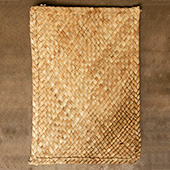Design Resource
Screw Pine Mat - Alleppey, Kerala
Craft of Weaving Mat
by
Prof. Bibhudutta Baral and Manasa K. H.
Alappuzha is also known as Alleppey, District of Kerala state of southern India. Kerala is a land of artistic people. You will find intricate designs and vibrant details on Kerala art and craft. Kerala is renowned for its carvings in metal and wood like rosewood and sandalwood, metal jewelry, granite statues, coconut shell and coir products etc.
Alleppey is known as the Venice of the east. Built in the 9th century AD it lies on the edge of the great Ashtamudi lake with the Arabian Sea on the west and a vast labyrinth of lakes, Alappuzha is a district of immense natural beauty. Raja Keshawadasan, divan of Travancore in 1762, brought this township into being. It is most commonly known for its enormous innate beauty, boat races, houseboat holidays, beaches, marine products, charming lagoons, Handicrafts etc.
In all the districts of Kerala screw pine crafts is practice by artisans; it has been in to existence since 800 years. The main centers of this craft in Kerala are Karunagapalli Taluk of Kollam District, Mavelikkara and Karthikapalli Taluks of Alappuzha dist. Thazava, Vachrai and Vallikunnam Panchayaths, some villages in Thiruvananthapuram and Kottayam Districts. The other handicrafts, which are practiced in alleppey, are Coconut based crafts, Vallam boat making, Coir work, Stone carving etc.
Screw pine is a plant that comes under Pandanus genus. The word Pandan is derived from an Indonesian name of a tree called Pandan, commonly known as screw pine and comes under pandanaceae family. It is a monocot plant with 750 accepted species, it is an old native shrub adapted to tropic and sub tropic regions. The leaf arrangement of the plant is like the threading of a screw, hence the name screw pine. The leaves have thorns on the sides and midrib and are very flexible.
The screw pine leaf is not water absorbent. Screw pine has the capacity to hold the soil tight and prevent the region from soil erosion. The root system is fibrous and holds the fine alluvial soil. The roof of houseboats in Kerala and the walls are all covered with screw pine mats, it adds to the aesthetics and gives a feel of traditional living.
Pandan is used for handicrafts. Green leaves are cut so the plant will naturally regenerate. The young leaves are sliced in fine strips and sorted for further processing. Weavers produce basic pandan mats of standard size or roll the leaves into pandan ropes for other designs. This is followed by a coloring process, in which pandan mats are placed in drums with water-based colors. After drying, the colored mats are shaped into final products, such as place mats or jewelry boxes. Final color touch-ups may be applied.
Screw pine is one of the oldest cottage crafts of Kerala; it is a product of daily use. A wide range of useful products are made out of screw pine including mats, hats, bags, files etc. As a substitute for plastic, it offers an eco-friendly choice. Screw Pine craftsmen collects the leaves of screw pine plants and the mature leaves are then cut. These leaves are then sliced in fine strips and sorted for further processing.
Many families in this village are involved in producing screw-pine fabric for generations. The many families that have been working with screw pine for generations are now practicing their art with more vigor and passion, because in the modern world this ancient tradition of Kerala is feared to be diminishing. Most of the practitioners, along with many enthusiasts, work hard to follow the traditional methods with a view of preserving its heritage and quality.




